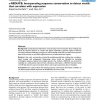820 search results - page 36 / 164 » Using Multiple Alignments to Improve Gene Prediction |
RECOMB
2010
Springer
13 years 5 months ago
2010
Springer
Abstract. We describe a probabilistic model, implemented as a dynamic Bayesian network, that can be used to predict nucleosome positioning along a chromosome based on one or more g...
RECOMB
2003
Springer
14 years 7 months ago
2003
Springer
We describe a novel method for detecting the domain structure of a protein from sequence information alone. The method is based on analyzing multiple sequence alignments that are ...
BMCBI
2008
13 years 7 months ago
2008
Background: Researchers interested in analysing the expression patterns of functionally related genes usually hope to improve the accuracy of their results beyond the boundaries o...
CF
2007
ACM
13 years 11 months ago
2007
ACM
In the life sciences, genomic databases for sequence search have been growing exponentially in size. As a result, faster sequencesearch algorithms to search these databases contin...
BMCBI
2008
13 years 7 months ago
2008
Background: Computational methods for characterizing novel transcription factor binding sites search for sequence patterns or "motifs" that appear repeatedly in genomic ...

